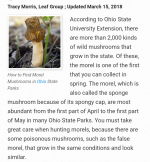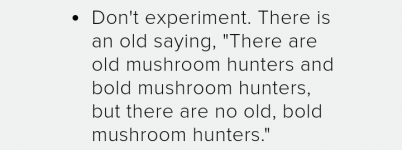You are using an out of date browser. It may not display this or other websites correctly.
You should upgrade or use an alternative browser.
You should upgrade or use an alternative browser.
Picking wild mushrooms
- Thread starter QSis
- Start date
Johnny West
Well-known member
Last night pulled a few weeds by my house and found a little morel. My neighbor usually has an area that provides a nice mess and since they are in AZ I went over and there they were. I'll dry some and have some in scrambled eggs for dinner.

Last edited by a moderator:
Johnny West
Well-known member
This morning I did up a mess of houby sautéed in ghee, added eggs and hog jowl bacon on the side. I baked the bacon and it came out brilliant.



Last edited by a moderator:
John, is there any left? I'll be right over!
I've been going on Youtube, trying to learn how to identify deciduous trees without leaves, to help in morel-hunting. Yesterday, I took a walk in tree-laden cemetery and it's more difficult than I thought. I wanted to find elms, and I think all I saw were oaks.
Lee
I've been going on Youtube, trying to learn how to identify deciduous trees without leaves, to help in morel-hunting. Yesterday, I took a walk in tree-laden cemetery and it's more difficult than I thought. I wanted to find elms, and I think all I saw were oaks.
Lee
According to a group I joined on FB, they are plentiful around here right now along the dam path amongst the trees, but you must be willing to explore and look for them.
Also being mindful that there are some which look similar. No no no!
So if I have a day where I can go "hunting" I shall.
They're from here to Independence and Jewell following the river and beyond.
I recall my Father being home on leave from the service and knowing exactly where to go to find these in a more southern county.
He also knew where to find asparagus growing wild and pawpaw.
I'll remember what you told me about hollow stems John.
Thanks!
Also being mindful that there are some which look similar. No no no!
So if I have a day where I can go "hunting" I shall.
They're from here to Independence and Jewell following the river and beyond.
I recall my Father being home on leave from the service and knowing exactly where to go to find these in a more southern county.
He also knew where to find asparagus growing wild and pawpaw.
I'll remember what you told me about hollow stems John.
Thanks!
Wow!
Lol



Lol
Last edited by a moderator:
LOL - thanks, Sass!
Lee
Take a look at this morel sighting map. I may have to move. https://www.thegreatmorel.com/maps/fullscreen/layer/6/
Lee
Take a look at this morel sighting map. I may have to move. https://www.thegreatmorel.com/maps/fullscreen/layer/6/
Last edited:
Tis the season.
Johnny West
Well-known member
I looked this morning and it appears they are done in this patch.
I'll check again tonight after it warms up.
I'll check again tonight after it warms up.
Johnny West
Well-known member
The neighbor got back from AZ yesterday so took him over a bag of dried morels. He said there were a lot more I could have and he wasn't kidding.




Last edited by a moderator:
Johnny West
Well-known member
The big ones I cleaned, froze and will fry up when I get home from UT. I had some minor oral surgery yesterday and want to heal up so I can enjoy them.
I have yet to find any morels, but the weather has been so hot and muggy this summer, that I went hunting for boletes.
Just found a few, and one little chanterelle. Dehydrated them in my toaster oven and added to the mesh bag I keep in the kitchen closet.
Will try again later this month.
Lee


Just found a few, and one little chanterelle. Dehydrated them in my toaster oven and added to the mesh bag I keep in the kitchen closet.
Will try again later this month.
Lee
Last edited:
It's been years since I've had a wild mushroom harvest anywhere near as good as today's was! Thanks to my friend, Barbara Carlin, for going into the woods with me - she has natural "mushroom eyes"!
Lot of fun!
Will clean and dehydrate tomorrow.
Lee

Lot of fun!
Will clean and dehydrate tomorrow.
Lee
This 2021 late summer/fall season continues to be great for all kinds of fungi! Through a couple of Facebook groups and several books I own, I'm learning a LOT about other kinds of edibles that I've never picked before. I've been foraging almost every day.
I'm almost brand-new to cooking with fresh wild mushrooms, since I've always just picked boletes and dried them for Polish mushroom soup. Very exciting to learn about other edible fungi, and with some of my first pick of milky caps (Lactarius hygrophoroides), I made a sauce of butter-sauteed milky caps and shallots to pour over guyere-topped chicken patties and egg noodles. Garnished with parsley and toasted pine nuts. We LOVED it!
Lee


I'm almost brand-new to cooking with fresh wild mushrooms, since I've always just picked boletes and dried them for Polish mushroom soup. Very exciting to learn about other edible fungi, and with some of my first pick of milky caps (Lactarius hygrophoroides), I made a sauce of butter-sauteed milky caps and shallots to pour over guyere-topped chicken patties and egg noodles. Garnished with parsley and toasted pine nuts. We LOVED it!
Lee
One of the saving graces of this long stretch of horrible heat, humidity and rain is the great yield of wild mushrooms, the few varieties that I pick.
Today, I found a fresh Chicken of the Woods (the orange thing), and I only picked about a third of it which I will saute in butter and a little wine to make an omelette. Found some huge boletes which I'm drying to use in pot roasts, pierogis, borscht and some to give away.
These dried wild mushrooms are really expensive to buy. Wonder if I could sell some to restaurants.
Lee


Today, I found a fresh Chicken of the Woods (the orange thing), and I only picked about a third of it which I will saute in butter and a little wine to make an omelette. Found some huge boletes which I'm drying to use in pot roasts, pierogis, borscht and some to give away.
These dried wild mushrooms are really expensive to buy. Wonder if I could sell some to restaurants.

Lee
Last edited:
SilverSage
Resident Crone
WOW! You could sell some to me! I love wild mushrooms,
One good thing about this stinking hot and humid weather is that it's bringing out mushrooms earlier in the season.
I found a perfectly beautiful, young Chicken of the Woods and harvested just about a 1/3 of it, to try cooking for the first time.
Wow, it's as delicious as my fellow mushroom foragers have said it is!
I tore the lobes into smaller pieces and browned them in a hot, dry pan. Then I added a couple of tablespoons of butter, then a minced garlic clove, then a splash of dry sherry. Wonderful!
Going to make an omelette tomorrow for breakfast!
Lee

I found a perfectly beautiful, young Chicken of the Woods and harvested just about a 1/3 of it, to try cooking for the first time.
Wow, it's as delicious as my fellow mushroom foragers have said it is!
I tore the lobes into smaller pieces and browned them in a hot, dry pan. Then I added a couple of tablespoons of butter, then a minced garlic clove, then a splash of dry sherry. Wonderful!
Going to make an omelette tomorrow for breakfast!
Lee
Kathy, I discovered that the mushrooms in that photo were bitter boletes AFTER I'd mixed them in with my 3/4 lb. Other dried mushrooms. I tossed them all. Starting over again.
Will bring you whatever new ones I have when I see you. The most fun is the hunt!
Lee
Will bring you whatever new ones I have when I see you. The most fun is the hunt!
Lee
Johnny West
Well-known member
I saw these popping up in beauty bark in front of hotel.


Johnny West
Well-known member
Lee, do you know what these are - growing in our tomatoes?

Johnny West
Well-known member
I think I found it….
Psilocybe stuntzii also known as Blue ringershttps://healing-mushrooms.net/psilocybe-stuntzii#_edn1, or Stuntz’s Blue Legs, is a weakly psychoactive mushroom common on lawns and pastures in the Pacific Northwest. It is not especially popular among recreational users, although it does have the advantage of fruiting into the winter when growing wild.
Gills: Attached. Off-white when young, turning brown with age.
Stem: Medium in length, sometimes thicker at the base, yellowish in color. A bluish ring, the remnant of the partial veil, is distinctive.
Spores: Elliptical.
Spore color: Purple-brown.
Edibility: Psychoactive.
Habitat: Often found in lawns, pastures, and mulch-beds. Usually fruits in groups.
Range: Found in Washington, Oregon, and California as far south as Los Angeles.
The blue ring[ii] around the stem is a subtle but very distinctive feature. Like many other Psilocybes, this mushroom will bruise blue when handled, but the bruising is not dramatic.

Psilocybe stuntzii also known as Blue ringershttps://healing-mushrooms.net/psilocybe-stuntzii#_edn1, or Stuntz’s Blue Legs, is a weakly psychoactive mushroom common on lawns and pastures in the Pacific Northwest. It is not especially popular among recreational users, although it does have the advantage of fruiting into the winter when growing wild.
Identification and Description
Cap: Small to medium-sized, conical when young, becoming nearly flat with a wavy edge with age. Variable in color, but often yellowish or greenish brown.Gills: Attached. Off-white when young, turning brown with age.
Stem: Medium in length, sometimes thicker at the base, yellowish in color. A bluish ring, the remnant of the partial veil, is distinctive.
Spores: Elliptical.
Spore color: Purple-brown.
Edibility: Psychoactive.
Habitat: Often found in lawns, pastures, and mulch-beds. Usually fruits in groups.
Range: Found in Washington, Oregon, and California as far south as Los Angeles.
The blue ring[ii] around the stem is a subtle but very distinctive feature. Like many other Psilocybes, this mushroom will bruise blue when handled, but the bruising is not dramatic.
Do yours have the blue rings on the stems?I think I found it….
Psilocybe stuntzii also known as Blue ringershttps://healing-mushrooms.net/psilocybe-stuntzii#_edn1, or Stuntz’s Blue Legs, is a weakly psychoactive mushroom common on lawns and pastures in the Pacific Northwest. It is not especially popular among recreational users, although it does have the advantage of fruiting into the winter when growing wild.
Identification and Description
Cap: Small to medium-sized, conical when young, becoming nearly flat with a wavy edge with age. Variable in color, but often yellowish or greenish brown.
Gills: Attached. Off-white when young, turning brown with age.
Stem: Medium in length, sometimes thicker at the base, yellowish in color. A bluish ring, the remnant of the partial veil, is distinctive.
Spores: Elliptical.
Spore color: Purple-brown.
Edibility: Psychoactive.
Habitat: Often found in lawns, pastures, and mulch-beds. Usually fruits in groups.
Range: Found in Washington, Oregon, and California as far south as Los Angeles.
The blue ring[ii] around the stem is a subtle but very distinctive feature. Like many other Psilocybes, this mushroom will bruise blue when handled, but the bruising is not dramatic.
View attachment 60741
I would have guessed Armillaria mellea or some species of "honey mushrooms". In any case, don't eat them.
Lee
Johnny West
Well-known member
I’m going to check this afternoon. I’d like to try them if they are honey -  .
.
Johnny West
Well-known member
No blue ring.Do yours have the blue rings on the stems?
I would have guessed Armillaria mellea or some species of "honey mushrooms". In any case, don't eat them.
Lee


